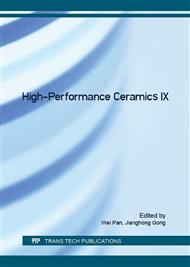p.109
p.113
p.119
p.124
p.129
p.134
p.138
p.143
p.148
Cellulose-Silica Composite Aerogels Prepared with Sodium Silicate by Freeze Drying Method
Abstract:
The cellulose-silica composite aerogels (CAs) were fabricated through a permeation sol-gel process in the regenerated cellulose hydrogels followed by freeze drying. The precursor Na2SiO3 instead of traditional organic precursor was diffused in the cellulose matrix followed by permeating the catalyst into the cellulose nanofibers network gradually to promote the in situ condensation of Na2SiO3 to form a SiO2 gel skeleton from outside to inside. The obtained CAs displayed the interpenetrating network (IPN) structure of the regenerated cellulose nanofibers network and the SiO2 gel skeleton in nanoscale. In the IPN structure, the flexible cellulose nanofibers network was supported by the hard inorganic network effectively to sustain the compression and the silica gel skeleton protect the cellulose nanofibers to avoid the remodeling of their shape in the process of solvent replacement before freeze drying. Due to the synergic effects of the different network, the IPN structure endows the CAs with high compression modulus (as high as 15.48 MPa), high specific surface area (as high as 621 m2 g-1) and low density (less than 0.182 g cm-3).
Info:
Periodical:
Pages:
129-133
Citation:
Online since:
July 2016
Authors:
Keywords:
Price:
Сopyright:
© 2016 Trans Tech Publications Ltd. All Rights Reserved
Share:
Citation:


